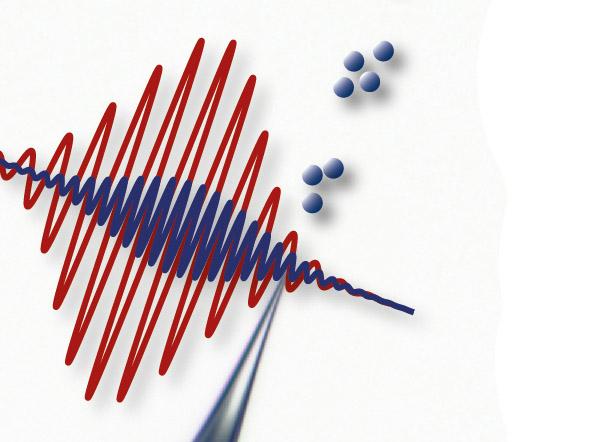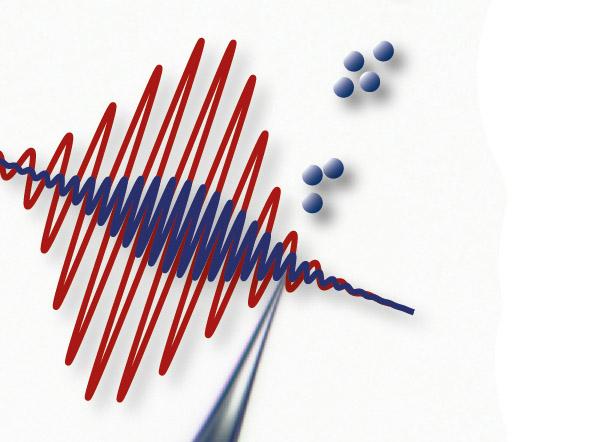
Credit: FAU Erlangen-Nürnberg
In an electron microscope, electrons are emitted by pointy metal tips, that way the can be steered and controlled with high precision. Recently, such metal tips have also been used as high precision electron sources for generating x-rays. A team of researchers at TU Wien (Vienna), together with colleagues from the FAU Erlangen-Nürnberg (Germany), have developed a method of controlling electron emission with higher precision than ever before. With the help of two different laser pulses it is now possible to switch the flow of electrons on and off on extremely short time scales.
It's Just the Tip of the Needle
"The basic idea resembles a lightning rod", says Christoph Lemell (TU Wien). "The electrical field around a needle is always strongest right at the tip. That's why the lightning always strikes the tip of a rod, and for the same reason, electrons leave a needle right at the tip."
Extremely pointy needles can be fabricated with the methods of modern nanotechnology. Their tip is just a few nanometres wide, so the point at which the electrons are emitted is known with very high accuracy. In addition to that, it is also important to control at which point in time the electrons are emitted.
This kind of temporal control has now become possible, using a new approach: "Two different laser pulses are fired at the metal tip", explains Florian Libisch (TU Wien). The colours of these two lasers are chosen such that the photons of one laser have exactly twice the energy of the other laser's photons. Also, it is important to ensure that both light waves oscillate in perfect synchronicity.
With the help of computer simulations, the team from TU Wien was able to predict that a small time delay between the two laser pulses can serve as a "switch" for electron emission. This prediction has now been confirmed by experiments performed by Professor Peter Hommelhoff's research group at FAU Erlangen-Nürnberg. Based on these experiments, it is now possible to understand the process in detail.
Absorbing Photons
When a laser pulse is fired at the metal tip, its electrical field can rip electrons out of the metal – that is a well-known phenomenon. The new idea is that a combination of two different lasers can be used to control the emission of the electrons on a femtosecond time scale.
There are different ways an electron can gain enough energy to leave the metal tip: It can absorb one photon from the high-energy laser and two photons from the low-energy laser or four electrons from the low-energy laser. Both mechanisms lead to the same result. "Much like a particle in a double slit experiment, which travels on two different paths at the same time, the electron can take part in two different processes at the same time", says Professor Joachim Burgdörfer (TU Wien). "Nature does not have to pick one the two possibilities – both are equally real and interfere which each other."
By carefully tuning the two lasers, it is possible to control whether the two quantum physical processes amplify each other, which leads to an increased emission of electrons, or whether they cancel each other, which means that hardly any electrons are emitted at all. This is a simple and effective way of controlling electron emission.
It is not just a new method of performing experiments with high energy electrons, the new technology should open the door to controlled x-ray generation. "Innovative x-ray sources are already being built, using arrays of narrow metal tips as electron sources", says Lemell. "With our new method, these nano tips could be triggered in exactly the right way so that coherent x-ray radiation is produced."
###
Further Information:
Prof. Joachim Burgdörfer
Institute for Theoretical Physics
TU Wien
Wiedner Hauptstraße 8-10, 1040 Vienna
T: +43-1-58801-13610
[email protected]
Dr. Florian Libisch
Institute for Theoretical Physics
TU Wien
Wiedner Hauptstraße 8-10, 1040 Vienna
T: +43-1-58801-13608
[email protected]
Media Contact
Florian Aigner
[email protected]
43-158-801-41027
@tuvienna
http://www.tuwien.ac.at/tu_vienna/
############
Story Source: Materials provided by Scienmag






